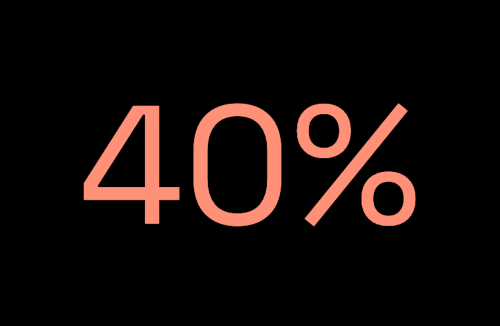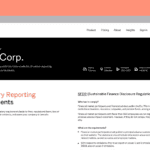How to close the accuracy gap in carbon footprint calculation

The accuracy gap stops businesses from calculating their full emissions – blocking opportunities & exposing risks.
Proactive business leaders understand that emissions management does more than fight climate change – it also keeps their businesses legally compliant and ready to seize opportunities.
These business leaders also know that to effectively manage their business’s emissions, they first need to measure them. However, research shows that 91% of businesses aren’t calculating their full emissions.
Here are the causes and consequences of this incompleteness in emissions calculations, and how businesses can overcome them.
The accuracy gap in carbon footprint calculation
The accuracy gap is the difference between the carbon emissions a company calculates and those for which it is accountable.
For many businesses, especially large enterprises with complex value chains, the accuracy gap can be sizable. In a 2021 survey, executives from global corporations in nine major industries estimated an error rate of up to 40% in their emissions calculations.

The average error rate in businesses’ own emissions estimates.
What causes the accuracy gap?
The accuracy gap can be traced back to the methodologies and data used in emissions estimates.
Businesses calculate their greenhouse gas emissions using two methodologies: spend-based and activity-based. In practice, businesses will often combine these two methodologies to achieve their calculations, using what’s called the “hybrid method.”
The spend-based method of calculating emissions uses the financial value of a purchased good or service to estimate the emissions produced. The activity-based method, on the other hand, uses the units of the product or material.
For example, “money spent on fuel” would be a spend-based data point for fuel usage, whereas the activity-based version would be “liters of fuel burned.”
Activity data results in more accurate emissions calculations per activity but is more difficult and time-intensive to source than spend-based data, especially in the value chain. Accordingly, most businesses can’t calculate their entire carbon footprints using only activity data. This is especially true for large enterprises, which have enormously complex value chains to parse.
The hybrid method provides comprehensiveness and precision
Therefore, the Greenhouse Gas Protocol’s Corporate Standard – the most widely-used framework for calculating corporate climate impacts – recommends that businesses follow the hybrid methodology. For most businesses, this involves performing an initial spend-based carbon footprint calculation to gain an emissions overview, then supplementing this calculation with activity data, beginning with the highest-emitting suppliers.
In other words, with the hybrid method, the spend-based estimates ensure that all of a business’s economic activities are accounted for while the activity-based calculations then provide increased accuracy.
This combination of comprehensiveness and precision is necessary for businesses to close the accuracy gap.

Carbon accounting, explained
Learn how businesses can accurately calculate their greenhouse gas emissions.
Even when a business accounts for every emissions source in its operations and value chain using spend-based or activity-based data, it may still have inaccurate calculations.
This is because data collection is only the first step. The next step is to multiply that data by an emissions factor: the amount of emissions produced per unit.
Going back to our previous example of fuel burn, an activity-based emissions factor would be “emissions produced per liter of fuel burned.” To calculate your business’s total emissions from fuel usage, you would simply multiply the total fuel burned by the emissions factor for that particular type of fuel.
A spend-based emissions factor, on the other hand, would be “emissions produced per currency unit spent on fuel.” You would then multiply the total spend on fuel by this cost emissions factor to arrive at the emissions estimate.
If a business is working from inaccurate or out-of-date emissions factors, the emissions estimates they arrive at while using them will also be inaccurate or out-of-date.
To sum up: inaccurate calculations occur when businesses either neglect to address all the sources of their emissions and/or use insufficient emissions factors.
Emissions calculations backed by 30 million data points
Normative’s carbon accounting engine uses 30 million data points – including 25,000 emissions factors sourced from scientific research – to provide comprehensive emissions calculations with industry-leading accuracy.
The consequences of the accuracy gap & the benefits of closing it
When businesses successfully close the accuracy gap, they avoid risks – including legal non-compliance – and earn benefits like increased brand equity.
Legal compliance
Carbon emissions reporting requirements are expanding across the globe, and becoming stricter in terms of their demands for detail and auditing.
Large companies in the UK must disclose emissions per SECR. In the EU, the expanded CSRD will require many previously-unaffected companies to disclose their emissions, beginning with the 2024 financial year.
Similarly, the US Securities and Exchange Commission (SEC) has recently unveiled a regulation proposal that would require public companies to disclose emissions.
For businesses that fall under these legislations, the choice is clear: report your full emissions or risk legal non-compliance and its consequences.
However, even if your business is currently not obligated to report its emissions, climate impact reporting mandates are expanding to cover more businesses all the time. By closing your accuracy gap today, you ensure that your business will meet the scope, detail, and auditing demands of this reporting legislation.
Preventing greenwashing & building brand equity
Greenwashing is often thought of as an intentional act. In traditional examples, a company tries to trick consumers into believing it’s doing environmental good when it’s actually doing harm.
However, many businesses are greenwashing without realizing it. With unintentional greenwashing, an organization believes that it’s being environmentally responsible and incorporates that message into their marketing and communications. But, unbeknownst to them, their environmental efforts are less effective or less comprehensive than they believe.
Businesses caught greenwashing – unintentionally or not – risk severe damage to their brand equity.
Unintentional greenwashing often begins at the first step of an organization’s climate action: its emissions calculation. By overcoming the accuracy gap in emissions calculation, you ensure that your business’s climate communications and reporting are credible.
This not only keeps your business greenwashing-resistant, but also creates business value and unlocks opportunities involving consumers, employees, and investors:
- 77% of consumers say it’s at least moderately important that brands are sustainable and environmentally responsible. [IBM]
- 2 in 3 employees are more likely to work for a company with strong environmental policies. [Unily/Censuswide]
- Investors will pay a 10% premium for a company with a positive ESG record. [McKinsey]
How to close the accuracy gap
At Normative, we’ve been empowering businesses to calculate their emissions since 2014. We’ve identified three principles that will enable you to overcome the accuracy gap and ensure successful emissions management across your business: comprehensive coverage, intelligent automation, and scientific integrity.
Comprehensive coverage ensures that your business calculates all of its emissions sources – including the value chain. Intelligent automation not only speeds up the process of obtaining calculations, but also helps prevent human error. And scientific integrity ensures that your business is using the most up-to-date data and methodologies to generate its emissions calculations.
For a real-world example of a business that closed the accuracy gap, we can look to MTC’s work with Normative.
MTC closed its accuracy gap using carbon accounting
Before coming to Normative, The Manufacturing Technology Centre (MTC) calculated emissions using its utility bills and government conversion factors.
The UK-based research and technology group suspected it was not reaching accurate results, so the firm reached out to Normative to help it obtain reliable carbon emissions data.
With Normative’s help, MTC expanded the amount of emissions sources it addressed, increasing the comprehensiveness of its coverage. The organization then ran these emissions sources through Normative’s automated carbon accounting engine, which drew from 8,000 scientifically-sourced emissions factors to derive full-scope emissions calculations.
The table below shows MTC’s original emissions calculations, compared to the emissions calculations MTC performed using Normative:
| MTC’s calculations and assumptions | Normative’s measurements | Change | |
|---|---|---|---|
| Scope 1 | 540 tCO2e | 657 tCO2e | +22% |
| Scope 2 | 978 tCO2e | 1,455 tCO2e | +49% |
| Scope 3 | 1,722 tCO2e | 8,780 tCO2e | +410% |
| Emissions sources measured | Gas Electricity Water Waste Employee commuting Business travel Procurement | Gas Electricity Water Waste Employee commuting Business travel Materials Transport of goods Transactions Fugitive emissions |
When comparing the two sets of results, at first glance the change may seem like a negative sign, as if MTC had suddenly produced more carbon emissions.
But of course, those emissions had been there all along – and by calculating them, MTC had closed its accuracy gap, empowering the organization to improve the accuracy of its legally-mandated reporting and to chart a path toward achieving net zero emissions.
FAQs
What is a carbon footprint calculator?
A carbon footprint calculator – such as Normative’s carbon accounting engine – can generate an estimate of an organization’s greenhouse gas emissions.
What is the accuracy gap in carbon footprint calculation?
The accuracy gap is the difference between the carbon emissions a company calculates and those for which it is accountable.
What are the benefits of closing the accuracy gap?
Businesses that close the accuracy gap in carbon footprint calculations will stay compliant with reporting legislation, become well-equipped to make effective carbon reductions, and be resistant to unintentional greenwashing.
Full-scope emissions calculations with industry-leading accuracy
Normative’s carbon accounting engine empowers your business to close the accuracy gap, keeping you risk-resistant and ready to seize business and climate opportunities.













